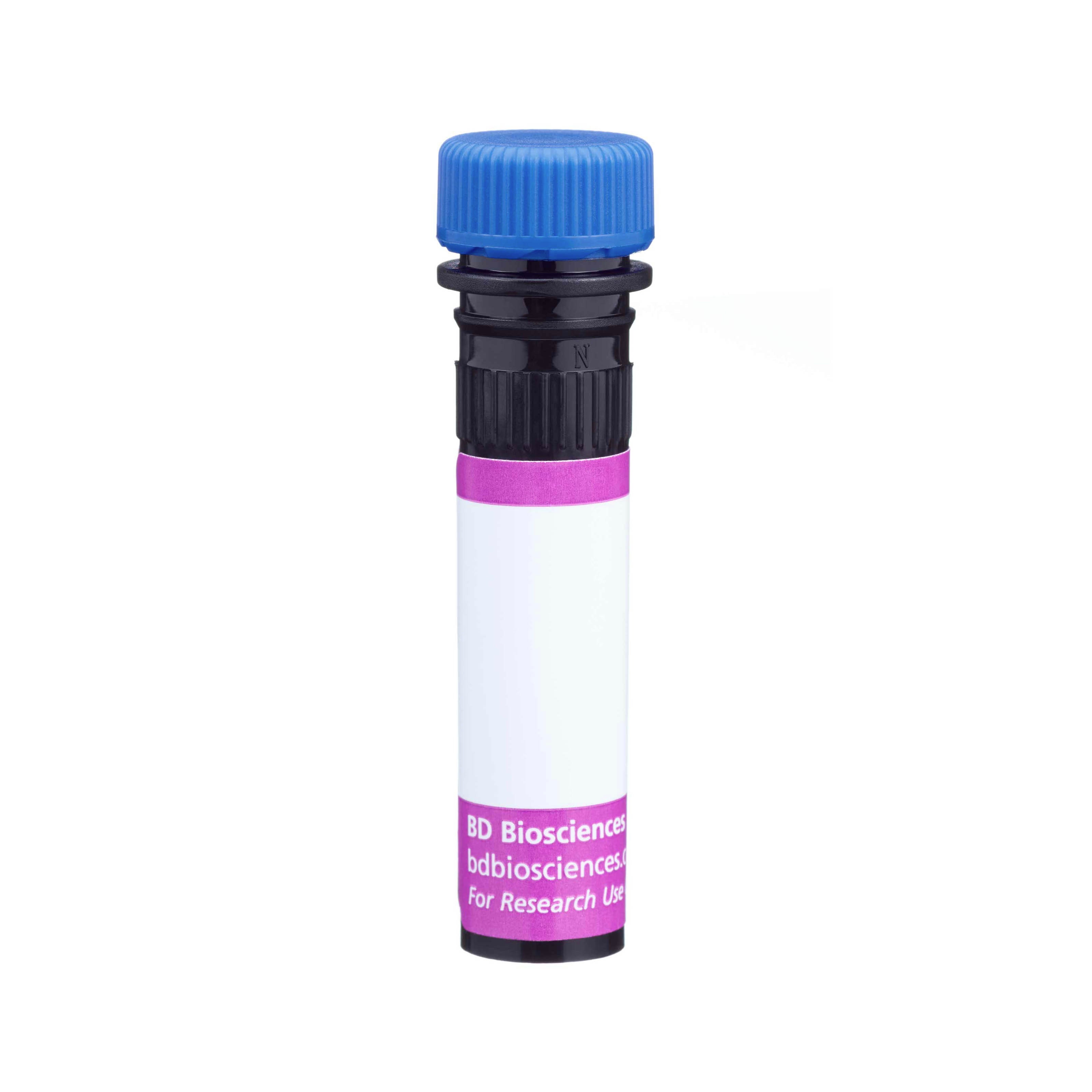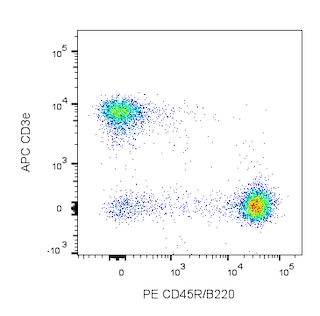Old Browser
This page has been recently translated and is available in French now.
Looks like you're visiting us from {countryName}.
Would you like to stay on the current country site or be switched to your country?




Multicolor flow cytometric analysis of CD150 expression by adult mouse spleen cells and bone marrow hematopoietic stem cells. (Panel A) BALB/c spleen cells were stained with PE Rat Anti-Mouse CD45R/B220 (Cat. No. 553090/553089/561878) and Brilliant Violet™ 421 Rat anti-Mouse CD150 (Cat. No. 562811), staining cells well above background compared to Brilliant Violet™ 421 Rat IgG2a, κ Isotype Control (Cat. No. 562602) (data not shown). A two-color flow cytometric dot plot shows the expression of B220 versus CD150 expressed by gated events with the forward and side-light scattering characteristics of viable lymphocytes. (Panel B) BALB/c mouse bone-marrow cells were labeled with the BD IMag™ Mouse Hematopoietic Progenitor Enrichment Set (Cat. No. 558451) and separated on the BD IMag™ Cell Separation Magnet (Cat. No. 552311) according to the set protocol. The non-depleted bone marrow cells were subsequently stained with APC Mouse Lineage Antibody Cocktail (Cat. No. 558074), FITC Rat Anti-Mouse CD41 (Cat. No. 553848/561849), APC-Cy™7 Hamster Anti-Mouse CD48 (Cat. No. 561242) and Brilliant Violet™ 421 Rat anti-Mouse CD150 antibodies. A fluorescence histogram (Right Plot) shows little or no CD41 expression (P4 Gate) by bone marrow cells that were progressively gated as viable (light-scatter gated). Lineage-negative CD48- CD150+ (Middle Plot, P3 Gate) bone marrow cells have been reported to be highly enriched for adult mouse hematopoietic stem cells. Flow cytometry was performed using a BD™ LSR II Flow Cytometer System.


BD Horizon™ BV421 Rat anti-Mouse CD150

Regulatory Status Legend
Any use of products other than the permitted use without the express written authorization of Becton, Dickinson and Company is strictly prohibited.
Preparation And Storage
Recommended Assay Procedures
For optimal and reproducible results, BD Horizon Brilliant™ Stain Buffer should be used anytime BD Horizon Brilliant™ dyes are used in a multicolor flow cytometry panel. Fluorescent dye interactions may cause staining artifacts which may affect data interpretation. The BD Horizon Brilliant Stain Buffer was designed to minimize these interactions. When BD Horizon Brilliant Stain Buffer is used in in the multicolor panel, it should also be used in the corresponding compensation controls for all dyes to achieve the most accurate compensation. For the most accurate compensation, compensation controls created with either cells or beads should be exposed to BD Horizon Brilliant Stain Buffer for the same length of time as the corresponding multicolor panel. More information can be found in the Technical Data Sheet of the BD Horizon Brilliant Stain Buffer (Cat. No. 563794/566349) or the BD Horizon Brilliant Stain Buffer Plus (Cat. No. 566385).
Product Notices
- Since applications vary, each investigator should titrate the reagent to obtain optimal results.
- An isotype control should be used at the same concentration as the antibody of interest.
- Source of all serum proteins is from USDA inspected abattoirs located in the United States.
- Caution: Sodium azide yields highly toxic hydrazoic acid under acidic conditions. Dilute azide compounds in running water before discarding to avoid accumulation of potentially explosive deposits in plumbing.
- For fluorochrome spectra and suitable instrument settings, please refer to our Multicolor Flow Cytometry web page at www.bdbiosciences.com/colors.
- Pacific Blue™ is a trademark of Molecular Probes, Inc., Eugene, OR.
- BD Horizon Brilliant Violet 421 is covered by one or more of the following US patents: 8,158,444; 8,362,193; 8,575,303; 8,354,239.
- BD Horizon Brilliant Stain Buffer is covered by one or more of the following US patents: 8,110,673; 8,158,444; 8,575,303; 8,354,239.
- Cy is a trademark of GE Healthcare.
- Please refer to www.bdbiosciences.com/us/s/resources for technical protocols.
Companion Products





The Q38-480 monoclonal antibody specifically binds to mouse CD150, also known as SLAM (signaling lymphocyte activation molecule). CD150 is a type 1 transmembrane glycoprotein that is a member of the CD2 subfamily of the Ig superfamily. It is encoded by the Slamf1 (signaling lymphocytic activation molecule family member 1) gene. CD150 is differentially expressed on subsets of thymocytes, T and B lymphocytes, dendritic cells, macrophages, and endothelial cells. SLAM plays multiple roles in innate and adaptive immunity serving as an adhesion molecule and/or coreceptor. CD150-mediated costimulation of TCR-activated T cells reportedly results in the increased production of IFN-γ by Th1 cells and is required for IL-4 production by T follicular helper cells. CD150 also plays important roles in hematopoietic cell developmental pathways. CD150 is differentially expressed by self-renewing adult hematopoietic stem cells (HSC) whereas non-multipotent hematopoietic progenitor cells are CD150-. Utilizing additional cell surface markers, lineage-negative CD150+CD48-CD41- cell fractions are reported to be highly enriched for adult HSC.

Development References (5)
-
Castro AG, Hauser TM, Cocks BG, et al. Molecular and functional characterization of mouse signaling lymphocytic activation molecule (SLAM): differential expression and responsiveness in Th1 and Th2 cells.. J Immunol. 1999; 163(11):5860-70. (Biology). View Reference
-
Guo H, Ma O, Friedman AD. The Cebpa +37-kb enhancer directs transgene expression to myeloid progenitors and to long-term hematopoietic stem cells.. J Leukoc Biol. 2014; 96(3):419-26. (Clone-specific: Flow cytometry). View Reference
-
Kiel MJ, Yilmaz OH, Iwashita T, Terhorst C, Morrison SJ. SLAM family receptors distinguish hematopoietic stem and progenitor cells and reveal endothelial niches for stem cells. Cell. 2005; 121(7):1109-1121. (Biology). View Reference
-
Wang N, Satoskar A, Faubion W, et al. The cell surface receptor SLAM controls T cell and macrophage functions. J Exp Med. 2004; 199(9):1255-1264. (Biology). View Reference
-
Yusuf I, Kageyama R, Monticelli L, et al. Germinal center T follicular helper cell IL-4 production is dependent on signaling lymphocytic activation molecule receptor (CD150). J Immunol. 2010; 185(1):190-202. (Biology). View Reference
Please refer to Support Documents for Quality Certificates
Global - Refer to manufacturer's instructions for use and related User Manuals and Technical data sheets before using this products as described
Comparisons, where applicable, are made against older BD Technology, manual methods or are general performance claims. Comparisons are not made against non-BD technologies, unless otherwise noted.
For Research Use Only. Not for use in diagnostic or therapeutic procedures.
Report a Site Issue
This form is intended to help us improve our website experience. For other support, please visit our Contact Us page.
